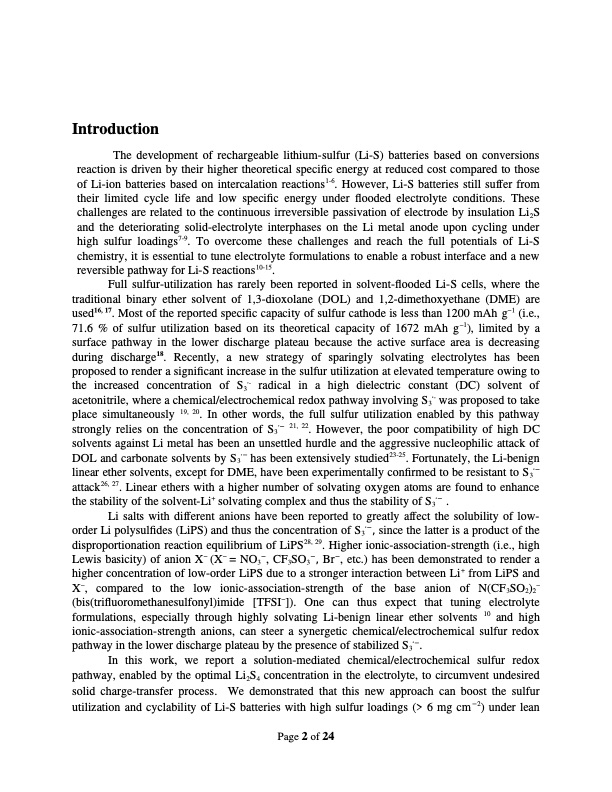
PDF Publication Title:
Text from PDF Page: 002
Introduction The development of rechargeable lithium-sulfur (Li-S) batteries based on conversions reaction is driven by their higher theoretical specific energy at reduced cost compared to those of Li-ion batteries based on intercalation reactions1-6. However, Li-S batteries still suffer from their limited cycle life and low specific energy under flooded electrolyte conditions. These challenges are related to the continuous irreversible passivation of electrode by insulation Li2S and the deteriorating solid-electrolyte interphases on the Li metal anode upon cycling under high sulfur loadings7-9. To overcome these challenges and reach the full potentials of Li-S chemistry, it is essential to tune electrolyte formulations to enable a robust interface and a new reversible pathway for Li-S reactions10-15. Full sulfur-utilization has rarely been reported in solvent-flooded Li-S cells, where the traditional binary ether solvent of 1,3-dioxolane (DOL) and 1,2-dimethoxyethane (DME) are used16, 17. Most of the reported specific capacity of sulfur cathode is less than 1200 mAh g−1 (i.e., 71.6 % of sulfur utilization based on its theoretical capacity of 1672 mAh g−1), limited by a surface pathway in the lower discharge plateau because the active surface area is decreasing during discharge18. Recently, a new strategy of sparingly solvating electrolytes has been proposed to render a significant increase in the sulfur utilization at elevated temperature owing to the increased concentration of S3∙- radical in a high dielectric constant (DC) solvent of acetonitrile, where a chemical/electrochemical redox pathway involving S3∙- was proposed to take place simultaneously 19, 20. In other words, the full sulfur utilization enabled by this pathway strongly relies on the concentration of S3∙− 21, 22. However, the poor compatibility of high DC solvents against Li metal has been an unsettled hurdle and the aggressive nucleophilic attack of DOL and carbonate solvents by S3∙− has been extensively studied23-25. Fortunately, the Li-benign linear ether solvents, except for DME, have been experimentally confirmed to be resistant to S3∙− attack26, 27. Linear ethers with a higher number of solvating oxygen atoms are found to enhance the stability of the solvent-Li+ solvating complex and thus the stability of S3∙− . Li salts with different anions have been reported to greatly affect the solubility of low- order Li polysulfides (LiPS) and thus the concentration of S3∙−, since the latter is a product of the disproportionation reaction equilibrium of LiPS28, 29. Higher ionic-association-strength (i.e., high Lewis basicity) of anion X− (X− = NO3−, CF3SO3−, Br−, etc.) has been demonstrated to render a higher concentration of low-order LiPS due to a stronger interaction between Li+ from LiPS and X−, compared to the low ionic-association-strength of the base anion of N(CF3SO2)2− (bis(trifluoromethanesulfonyl)imide [TFSI−]). One can thus expect that tuning electrolyte formulations, especially through highly solvating Li-benign linear ether solvents 10 and high ionic-association-strength anions, can steer a synergetic chemical/electrochemical sulfur redox pathway in the lower discharge plateau by the presence of stabilized S3∙−. In this work, we report a solution-mediated chemical/electrochemical sulfur redox pathway, enabled by the optimal Li2S4 concentration in the electrolyte, to circumvent undesired solid charge-transfer process. We demonstrated that this new approach can boost the sulfur utilization and cyclability of Li-S batteries with high sulfur loadings (> 6 mg cm−2) under lean Page 2 of 24PDF Image | A lithium-sulfur battery with a solution-mediated pathway

PDF Search Title:
A lithium-sulfur battery with a solution-mediated pathwayOriginal File Name Searched:
qt9bt5f7wt_noSplash_4e336387563ecb2106bd171b37448483.pdfDIY PDF Search: Google It | Yahoo | Bing
Sulfur Deposition on Carbon Nanofibers using Supercritical CO2 Sulfur Deposition on Carbon Nanofibers using Supercritical CO2. Gamma sulfur also known as mother of pearl sulfur and nacreous sulfur... More Info
CO2 Organic Rankine Cycle Experimenter Platform The supercritical CO2 phase change system is both a heat pump and organic rankine cycle which can be used for those purposes and as a supercritical extractor for advanced subcritical and supercritical extraction technology. Uses include producing nanoparticles, precious metal CO2 extraction, lithium battery recycling, and other applications... More Info
| CONTACT TEL: 608-238-6001 Email: greg@infinityturbine.com | RSS | AMP |